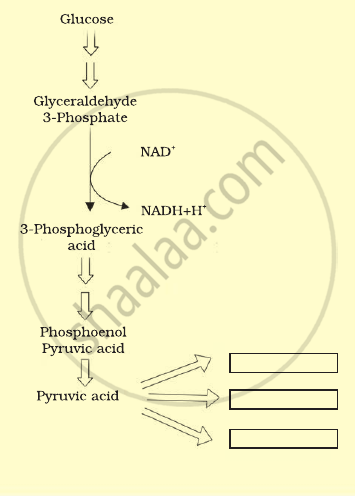Advertisements
Advertisements
Questions
Differentiate between Glycolysis and Krebs’ cycle.
Differentiate between Glycolysis and Citric acid Cycle.
Solution
| Glycolysis | Krebs' cycle (Citric acid Cycle) | |
| 1. | It takes place within the cytoplasm. | The Kreb's cycle functions within the mitochondria. |
| 2. | The first stage of respiration, known as glycolysis, breaks down glucose to produce pyruvate. | The second stage of respiration, known as Kreb's cycle, is when an active acetyl group is fully broken down. |
| 3. | Both the aerobic and anaerobic modes of respiration use the same procedure. | It only happens during aerobic respiration. |
| 4. | It breaks down a glucose molecule into two pyruvate molecules, an organic material. | Pyruvate is entirely broken down into organic matter (CO2 + H2O). |
| 5. | Two ATP molecules are used by glycolysis to phosphorylate the substrate molecule once. | ATP is not used by it. |
| 6. | During glycolysis, phosphorylation at the substate level releases four ATP molecules from one glucose molecule. | Through substrate-level phosphorylation, two acetyl residues release two ATP or GTP molecules in Kreb's cycle. |
| 7. | For each glucose molecule broken down, there is a net gain of two molecules of NADH and two molecules of ATP. | For every two molecules of acetyl CoA that the Krebs cycle oxidises, it produces two molecules of FADH2 and six molecules of NADH. Two pyruvates are converted to acetyl CoA, releasing two molecules of NADH in the process. |
| 8. | The energy gained net is equivalent to 8 ATP. | The total energy gained is equivalent to 24 ATP molecules. Two NADH2 molecules created when two pyruvates are dehydrogenated can provide six ATP molecules. |
| 9. | In glycolsis, no carbon dioxide is produced. | The Krebs cycle produces carbon dioxide. |
| 10. | Glycolysis does not require oxygen. | As the terminal oxidant in the Krebs cycle, oxygen. |
APPEARS IN
RELATED QUESTIONS
Distinguish between the following:
Glycolysis and Fermentation
The adenosine triphosphate (ATP) gain during glycolysis, connecting
link and Krebs' cycle respectively are ___
(a) 8, 6, 24
(b) 8, 24, 6
(c) 24, 8, 6
(d) 6, 8 24
Name the reactions when a-ketoglutarate is converted to succinyl Co-A in Krebs' cycle
In glycolysis, phosphorylation reaction leads to conversion of glucose to glucose-6-phosphate. Identify the number of carbon atoms that are added to glucose to make it glucose-6-phosphate.
______ is used for conversion of 3-PGA to 2-PGA in glycolysis.
Which of the following occurs during preparatory phase of glycolysis?
How many oxygen molecules are utilized in glycolysis?
During glycolysis of one molecule of glucose, how many ADP molecules are phosphorylated?
During glycolysis of aerobic respiration, how many times oxidation of substrate occurs?
Which process does the following equation represent?
\[\ce{C6H12O6 + 2NAD + 2ADP + 2Pi → CH3 - CO - COOH + 2 NADH2 + 2 ATP}\]
Which one of the following is the first step of glycolysis?
How many molecules of pyruvic acid are formed in glycolysis?
Pyruvic acid is the end product of glycolysis. What are the three metabolic products of pyruvic acid produced under aerobic and anaerobic conditions? Write their name in the space provided in the diagram.

The energy yield in terms of ATP is higher in aerobic respiration than anaerobic respiration. Why anaerobic respiration occurs even in organisms that live in aerobic condition like human beings and angiosperms?
Comment on the statement – Respiration is an energy producing process but ATP is being used in some steps of the process.
Write any two energy yielding reactions of glycolysis.
Formation of acetyl CoA from pyruvic acid takes place by ______.
The first three steps of glycolysis are called as ______.
